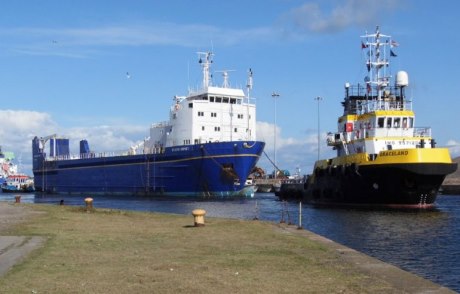After years of transporting materials to facilitate nuclear recycling, UK-registered nuclear cargo vessel Atlantic Osprey has begun its final voyage to the Swansea dock where it is itself destined to be broken up and recycled.
 |
| The Atlantic Osprey is towed from its berth in Barrow-in-Furness to Swansea (Image: INS) |
Atlantic Osprey is owned by the UK Nuclear Decommissioning Authority (NDA) and operated by NDA's wholly-owned subsidiary International Nuclear Services (INS). The 27-year old ship was modified from a merchant navy vessel purchased by British Nuclear Fuels Limited (BNFL) in 2001, and met the International Maritime Organisation (IMO) INF2 classification for the safe carriage of packaged nuclear materials. This allowed it to transport used nuclear fuel, high-level waste and plutonium up to limits set according to the aggregate radioactivity of the load.
Described by INS as one of the most versatile nuclear cargo vessels in operation, Atlantic Osprey was capable of accepting a wide range of cargoes including road vehicles laden with mixed-oxide (MOX) fuels. Before being withdrawn from service in December 2013, the ship's voyages had included the transport of MOX fuel from the UK to Switzerland and Germany, as well as transports of used reactor fuel and radioactive sources from Europe to the USA.
The ship set off on its final voyage from Barrow-in-Furness to Swansea Dry Dock on 19 August. Whereas previously decommissioned nuclear transport vessels operated by INS were broken up and recycled largely while still on the water, carrying out the work in a dry dock will allow more effective cleaning and recycling techniques to be used. Some 95% of the ship will be ultimately be recycled, according to INS.
INS's remaining fleet - the Oceanic Pintail, owned by NDA, and Pacific Nuclear Transport Ltd's (PNTL) Pacific Heron, Pacific Grebe and Pacific Egret - were all purpose-built for nuclear transport and are certified to the IMO's highest level, INF3, allowing them to carry used nuclear fuel, high-level waste and plutonium with no limit on the maximum aggregate radioactivity of the materials carried.
Researched and written
by World Nuclear News




_18570.jpg)
_18938.jpg)
_33584.jpg)
_82983.jpg)





